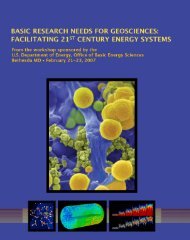Cyber Physical Systems â Situation Analysis - Energetics Meetings ...
Cyber Physical Systems â Situation Analysis - Energetics Meetings ...
Cyber Physical Systems â Situation Analysis - Energetics Meetings ...
- No tags were found...
You also want an ePaper? Increase the reach of your titles
YUMPU automatically turns print PDFs into web optimized ePapers that Google loves.
<strong>Cyber</strong> <strong>Physical</strong> <strong>Systems</strong> – <strong>Situation</strong> <strong>Analysis</strong>DRAFT – March 9, 2012include traffic signal violation warnings, stop sign violation warnings, pedestrian crossing information,and left turn assistance. 236One example of a technology that could be applied to future systems with V2V communications is analgorithm being developed by the Massachusetts Institute of Technology. The algorithm predicts when adriver will run a red light, allowing the possibility that this information could be used to alert other driversin the intersection, thus reducing the probability of a collision. 237DOT has joined with the Crash Avoidance Metrics Partnership to develop and test V2V safetyapplications with prototype vehicles, and it has been gathering data to assess usability and safety. SafetyPilot Driver Clinics, for example, will help determine driver response and acceptance of V2Vcommunications technologies. A Safety Pilot ModelExamples of CurrentAutonomous VehiclesGoogle CarGoogle has developed numerous autonomousToyota Priuses that have already driven morethanover 190,000 miles in city traffic, busyhighways, and winding country roads. The GoogleCar drives autonomously using a large lasermounted on top of the vehicle, four radars, globalpositioning system aidGPS, and many othersensors to measure and react to the surroundingenvironment while avoiding obstacles andobeying traffic laws.DARPA Urban ChallengeIn 2007, the Defense Advanced ResearchProjects Agency held the Third3 rd UrbanChallenge, in which competing autonomousvehicles had to drive in an urban environmentamong other autonomous vehicles as well asthose driven by people.Grand Cooperative Driving ChallengeThe first Grand Cooperative Driving Challengewas held in the Netherlands in May 2011.Autonomous vehicles competed and had tocommunicate with each other while navigatingurban and highway environments to performcooperative driving.Development is also planned and will include asmany as 3,000 vehicles, including cars, trucks, andbuses that have a mixture of integrated safetyapplications as well as aftermarket devices. Thevehicles will communicate using Dedicated ShortRange Communications technology that broadcastsover a dedicated frequency of 5.9 gigahertz. Resultsfrom this program will inform the National HighwayTraffic Safety Administration (NHTSA) as it decideswhether or not to take regulatory action concerningV2V and V2I communications systems. 238Multi-Vehicle Cooperative Drivingand Intersection Control ResearchIndividual-vehicle-control research concentrates onguaranteeing driving safety. As previously noted,increased traffic congestion is now making multivehicle-controlresearch an important topic forresearch in CPS. Twenty years ago researchersstarted examining lane changing- and lane-mergingcontrolproblems. A solution to those problemscomes from the path planning literature, whichstudies how to generate a collision-free driving pathor trajectory under the given vehicle dynamics. Onthe basis of these studies, researchers now considercooperative driving with inter-vehicle communication to be a more promising answer to the problems oftraffic jams and collisions.Japan‘s Association of Electronic Technology for Automobile Traffic and Driving was the first tointroduce cooperative driving in the early 1990s. Using appropriate inter-vehicle communication to linkvehicles, cooperative driving lets vehicles safely change lanes and merge into traffic, improving trafficcontrol performance. Since then, many other studies have addressed the feasibility and benefits of236 http://www.nhtsa.gov/DOT/NHTSA/NVS/Crash%20Avoidance/Technical%20Publications/2010/811381.pdf237 http://web.mit.edu/newsoffice/2011/driving-algorithm-1130.html238 U.S. DOT RITA. ―Connected Vehicle Research.‖45
















